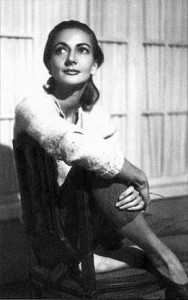Cradle Song is a 1953 Mexican film. It was directed by Fernando de Fuentes.

Resurrection (Spanish: Resurrección) is a 1943 Mexican period drama film directed by Gilberto Martínez Solares and starring Emilio Tuero, Lupita Tovar, Sara García and Rafael Banquells. It is based on the 1899 novel Resurrection by Leo Tolstoy. It relocates Tolstoy's story to Mexico in the early 20th century, at the brink of the Mexican Revolution and its land reform. The film's sets were designed by the art director Manuel Fontanals.
Emilio García Riera was a Spanish-born Mexican actor, writer and cinema critic. He has written exhaustively on Mexican cinema of 1929 and 1976, leaving behind an anthology in eighteen volumes, Historia documental del cine mexicano.

Isabel del Puerto was an Austrian-born noblewoman Mexican-American model, actress, dancer, writer, photojournalist, realtor and entrepreneur, and is the daughter of Charlotte Helene Beer and Alfred Joseph von Hortenau, a cavalry officer in the Austro-Hungarian Army and illegitimate son of the Archduke Otto Francis of Austria. Her parents divorced when she was two years old.
José García Narezo was a Mexican painter and a founding member of the Salón de la Plástica Mexicana.
Emilio García may refer to:

María Luisa Elío Bernal was a Spanish writer and actress exiled in Mexico. She wrote two books and the script of the award-winning autobiographical film El balcón vacío, which was the first film to depict the lives of Spanish exiles during the Spanish Civil War. She also performed on Mexican television and Mexican films. Elío was involved in several cultural and literary circles. She was also an inspiration for Gabriel García Márquez. His masterwork One Hundred Years of Solitude was dedicated to Elío and her husband.
The Two Orphans is a 1944 Mexican historical drama film directed by José Benavides hijo and starring Susana Guízar, Julián Soler and María Elena Marqués. It is an adaptation of the play The Two Orphans by Adolphe d'Ennery and Eugène Cormon, one of a large number of film versions that have been made.

My Memories of Mexico is a 1944 Mexican historical musical film directed as well as written by Juan Bustillo Oro and starring Fernando Soler, Sofía Álvarez, Joaquín Pardavé, Dolores Camarillo and Salvador Quiroz. The film nostalgically recreates the years of the Porfirio Díaz dictatorship in Mexico. It was shot at the Azteca Studios in Mexico City. The film's sets were designed by the art director Luis Moya.
Arturo Manrique (1910–1971) was a Mexican film actor.
José Rodríguez Granada was a Mexican art director who worked on more than two hundred films during his career.
Seven Women is a 1953 Mexican drama film directed by Juan Bustillo Oro and starring Amelia Bence, Alma Rosa Aguirre and Bárbara Gil. It is based on a play of the same name which had previously been adapted into the 1944 Argentine film Seven Women.
Juan García Garza, nicknamed "El Peralvillo", was a Mexican actor and screenwriter. He wrote the screenplays of the films of comedian Germán Valdés, beginning in Tender Pumpkins (1949), and was credited for the street talk featured in Valdés's films.
Alejandro Cobo Higuera was a Spanish-Mexican actor. He worked in the Golden Age of Mexican cinema, in films such as Virgen de medianoche (1942), The Eternal Secret (1942), The White Monk (1945), Hermoso ideal (1948), The Genius (1948) and The Magician (1949). He was the stepfather of Roberto Cobo.
José Martínez Grifell, best known as Pepe Martínez, was a Mexican actor who appeared as a supporting actor in several films during the Golden Age of Mexican cinema. He was the son of actress Prudencia Grifell.
Beatriz Saavedra is a Mexican actress, best known for appearing in films such as Monte de piedad (1951), Tres hombres en mi vida (1952), Tío de mi vida (1952), It Happened in Acapulco (1953), La ladrona (1954), Madame X (1955), Drop the Curtain (1955), La doncella de piedra (1956), and La culta dama (1957).
Martha Valdés was a Mexican actress. She is known for her work in several films during the Golden Age of Mexican cinema in the 1950s before disappearing from the scene at the end of the decade, such as Espaldas mojadas (1955), Cómicos de la legua (1957), Música de siempre (1958), and Vagabundo y millonario (1959).
Lupe del Castillo was a Mexican actress who appeared during the Golden Age of Mexican cinema in supporting roles, usually as a maid or an elderly woman. Her films include Peach Blossom (1945), Rosenda (1948), and Comisario en turno (1949).

Irma Torres was a Mexican film and television actress during the golden age of Mexican cinema.

A Woman's Diary is a 1944 Mexican drama film directed by José Benavides and starring Sofía Álvarez, Luis Aldás and Rafael Baledón. It was shot at the Azteca Studios in Mexico City. The film's sets were designed by the art director Luis Moya.






